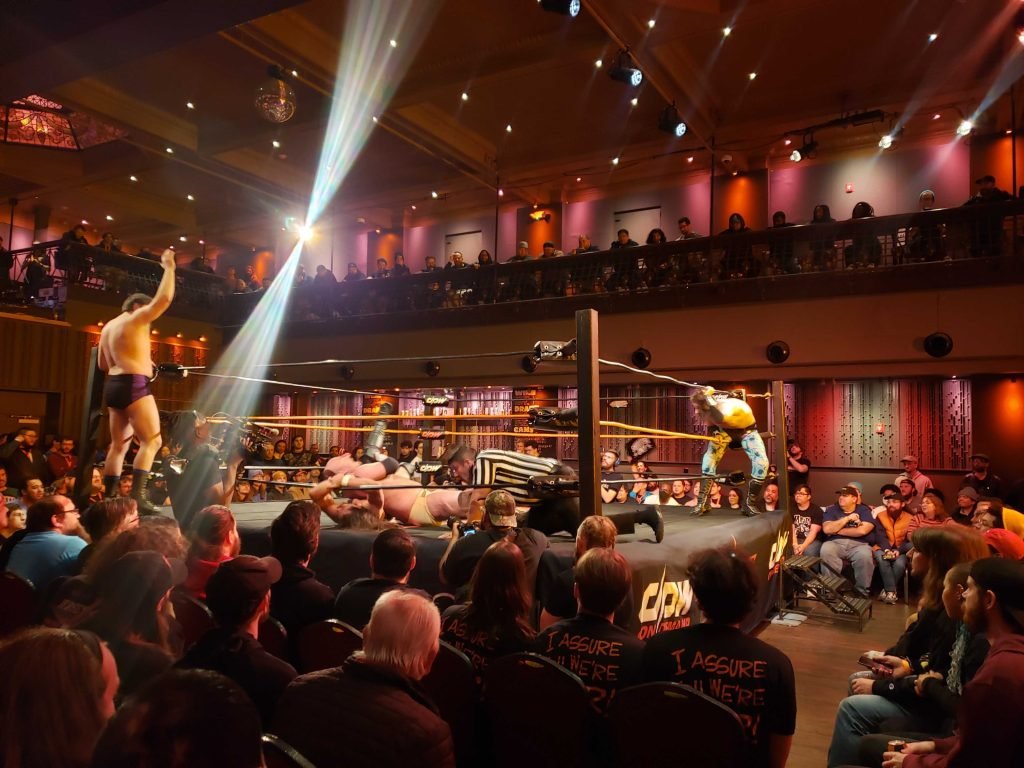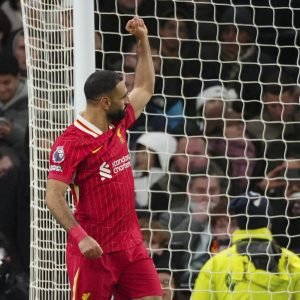
JERSEY CITY, N.J. — You’re probably going to have a good time at the independent wrestling show.
Just a few small things need to go your way: It shouldn’t be longer than three hours; the matches should have a decent pace to them; the venue should have air conditioning; and the largest, sweatiest, most obnoxious men should avoid standing directly in front of you. Nail all these parts, and I can almost guarantee you that something will click. Maybe the entrances will remind you of a drag show. Maybe the flips will take your breath away. Maybe you’ll love trying to decipher the inner workings of the performance. Maybe you’ll really like gawking at shirtless men from so close.
In a small act of vulnerability, I took a complete wrestling newcomer (Defector contributor Michael Waters) to an indie show in Jersey City on Sunday. (They have some really pretty Christmas lights on Newark Avenue right now!) It was the North Carolina–based Deadlock Pro-Wrestling’s World’s Strongest, and I had high expectations; a few weeks earlier, while streaming a show of theirs from Charlotte, I compared the passionate atmosphere at the three-year-old promotion to vintage Ring of Honor—a hugely influential cult favorite company that had provided an underground alternative while WWE maintained a monopoly on the mainstream. The business of running an indie wrestling promotion has changed drastically since legends like CM Punk, Bryan Danielson, and Samoa Joe signed their first major TV contracts. But even with stiff competition DPW stands out for its development of local talent, its impeccable taste in special guest stars, and—most of all—its consistently entertaining and vigorous matches.
World’s Strongest met all the requirements of a good indie show (and it debuts on DPW streaming Saturday, if you want to see for yourself). Situated right next to the announcer’s table, standing against the wall of the venue behind four rows of chairs, we watched seven matches that each justified our investment in them. The furious pace was set by an opening tag featuring Deadlock mainstays Andrew Everett and BK Westbrook against a couple of beefy cowboys, and it hit a pre-intermission high with a lucha libre match involving The Beast Mortos, Arez, and Rey Horus. You might’ve seen guys flip around on TV, but when you’re right there, in a tiny venue, you’ll almost definitely feel this rising thrill in your heart that transcends the planned nature of what you’re watching. When the Jersey crowd did the lucha tradition of throwing money in the ring at the end of the match, it felt like earnest rapture and not cosplay.
The biggest international star on the card, Kushida, made a welcome appearance for a second-half match that had an obvious face-saving non-ending. Then indie cornerstone “Speedball” Mike Bailey, who’s reportedly on his way to bigger money in All Elite Wrestling, delivered another of his impossibly common high-octane matches, taking two out of three falls from Titus Alexander. (I actually caught myself believing at one point that Bailey was about to buck all the tenets of wrestling storytelling to drop two successive falls as a favor before he leaves for basic cable.) And finally, Jake Something—my least favorite name in wrestling but my No. 1 certified bear—defended his title against an eager villain in Donovan Dijak. Through much of the show, the fans seemed to be having such a good time that they were reluctant to boo anyone. (They repeatedly and loudly chanted the name of the promotion to signify their satisfaction.) But Something vs. Dijak was more of a traditional good guy/asshole encounter in the classically effective pro wrestling style, and the fans did their part to provide the heel heat. It was the conclusion to an ideal introduction to pro wrestling—if not one completely free of complication.
All across the country there are small wrestling companies who gather unaffiliated freelancers to show fans a good time—the Pacific Northwest seems notably blessed to have Prestige and Defy—but Deadlock stands out to me for the way the three podcasters who started it have kind of Moneyballed their way to sustained success by making smart bets on rising American talent, utilizing gifted but relatively underseen wrestlers from Japan, and filling in the gaps with seasoned pros like Speedball and Something. In their short history, they’ve already made some majorly successful bets. In 2022, they got three standout matches from AEW’s Konosuke Takeshita just as he was starting to build momentum in the States. In 2023, they gave a huge and deserved push to local teen Jay Malachi, who’s since been rechristened “Je’Von Evans” as he’s become one of the brightest rising stars in WWE developmental. And in 2024, particularly as former AEW tag champs FTR wrestled Violence Is Forever last month, it’s apparent that wrestlers who don’t need to work indies nevertheless want the Deadlock experience. It seems like a cool place to be.
If Deadlock existed 10 years ago, it’d be something like an east-coast version of Pro Wrestling Guerrilla—a trend-setting super-indie that put together buzzy matches for a serious audience unenthused by the WWE product. But things have changed, and not just because online streaming has made it so every wrestling match on the globe is competing with every other match. The launch of AEW in 2019, fueled by Tony Khan’s deep pockets and his insatiable love of nerd shit, has vastly expanded the number of full-time TV jobs available for an American pro wrestler. Concurrently, the revamped, UFC-merged, McMahon-less WWE is less content than ever to let the indies do their own things. Only in this era would WWE have signed someone like Jay Malachi so quickly, without first requiring him to build up years and years of credibility. But now they have slots to fill in developmental and an incentive to keep talent away from AEW, so their mindset is haste. The recently unveiled “WWE ID” program takes things a step further, branding indie wrestlers and tossing them some money in exchange, reportedly, for a right of first refusal on a full-time deal.
Plenty of wrestlers and fans like this system because of the mainstream publicity and the fact that indie wrestling is a rough way to make a living. (Certainly Deadlock’s monthly cards are no substitute for a full-time job.) There was even a fresh WWE ID recruit at the Deadlock show—21-year-old Jackson Drake, who has TV-ready looks and really knew how to find the camera during his match. But it still stinks of monopoly, or perhaps a duopoly with AEW, that seeks to preemptively squash a spiritual successor to peak Ring of Honor—an ecosystem with its own legends and its own traditions. Especially with the oft-revolutionary Japanese scene stifled by the fall of the yen and the lingering effects of COVID, it’s massively important that the U.S. has a thriving, diverse wrestling landscape. But because WWE and AEW have all the money, they have all the control.
Gone are the days when someone as gifted as Bryan Danielson, or El Generico, or Kevin Steen could spend practically a full career in its own right building a rep in places like Jersey City’s White Eagle Hall before finally getting a shot on national television. Now, if you’re good, you’ll get noticed fast, and you’ll likely get signed to a contract that means you can’t be a regular at a place like Deadlock anymore. The inherent turnover means that it’ll continue to be a constant struggle for the promotion to maintain a foundation that carries over from show to show. They won’t ever have a real franchise player, or a face of the company—at least not for very long. Their own scouting will have to suffice. I hope they don’t end up like the Oakland A’s.






